Power electronic handbook
Подождите немного. Документ загружается.

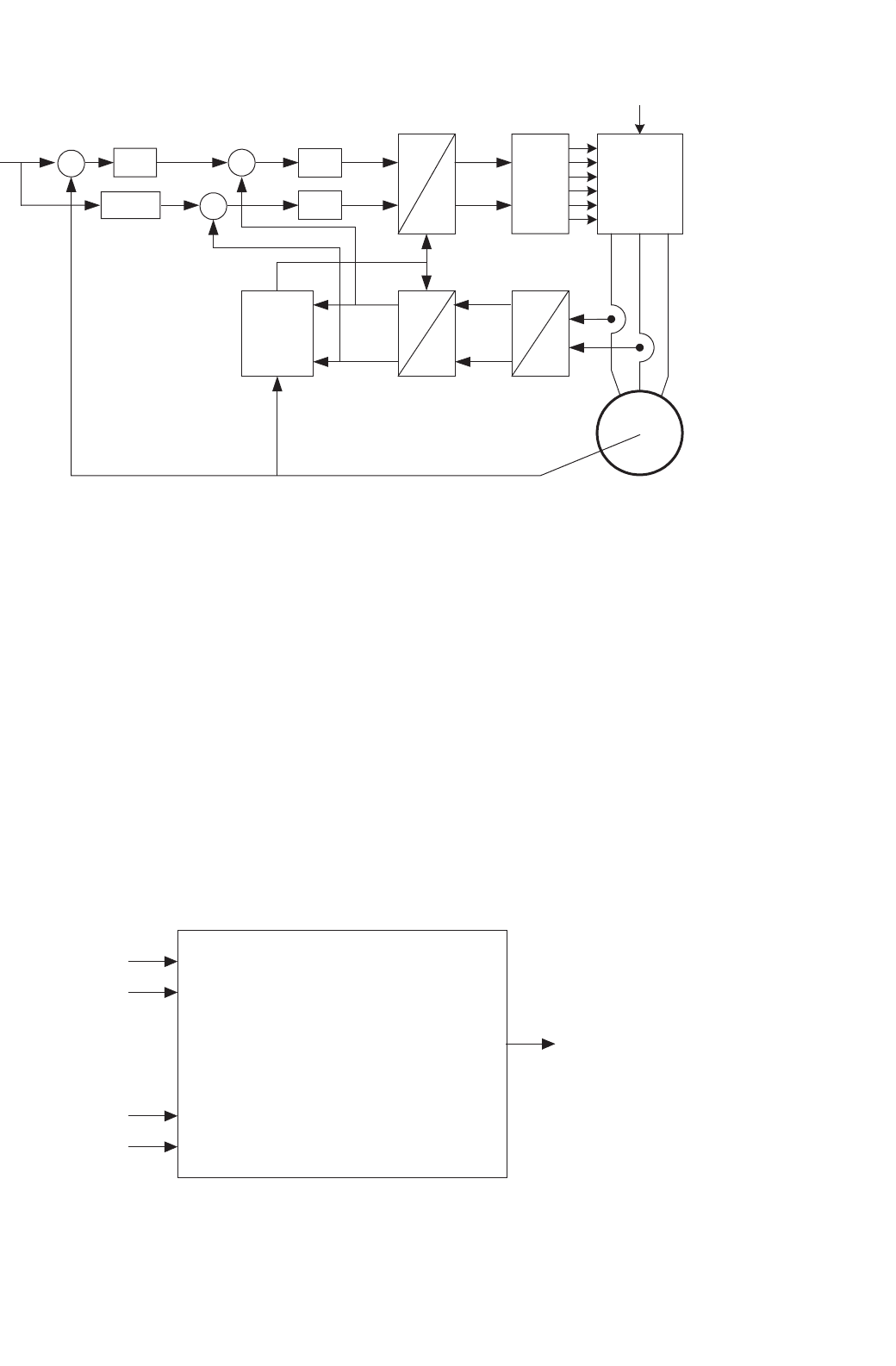
1048 H. A. Toliyat et al.
Flux
Controller
PI
PI
PI
SV
PWM
3-phase
Inverter
Induction
Motor
abc
Current
Model
−
i
ds
−
−
Vdc
Clarke
Transformation
Park
Transformation
Inv. Park
Transformation
θ
r
+
+
+
Mechanical Speed of Rotor
e*
i
qs
e*
v
qs
e*
v
ds
e*
v
qs
s*
v
ds
s*
dq
s
s
dq
s
s
dq
s
e
dq
s
e
dq
s
s
w
ref
w
rm
Σ
Σ
Σ
i
ds
s
i
ds
e
i
qs
s
i
qs
e
FIGURE 37.23 Vector-control algorithm for induction motor.
37.6.2 DSP Controller Requirements
The controller of the induction motor control system is used to
read the feedback current and position signals, to implement
the speed or torque control algorithm, and to generate the
gate signals based on the control signal. Analog controllers or
digital signal processors, such as LF2407 can perform these
tasks.
The interface of the LF2407 is illustrated in Fig. 37.24.
Two quadrature counters detect the rising and falling edges
of the encoder signals. Two input channels related to the 10-
bit ADC are selected to read the two-phase currents. The pins
PWM1 to PWM6 output the gating signals to the gate drive
circuitry.
QEP-1
QEP-2
PWM-1 & PWM-6
Gate
Drive
TMS320F2407
En A
ADCIN-1
ADCIN-0I
a
Ib
En B
FIGURE 37.24 The interface of LF2407.
37.6.3 Implementation of Field-oriented Speed
Control of Induction Motor
Some practical aspects of implementing the block diagram
of Fig. 37.24 are discussed in this section and subsections.
The software organization, the utilization of different vari-
ables, and the handling of the DSP controller resources are
described. In addition, the control structure for the per-unit
model is presented. Next, some numerical considerations have
been made in order to address the problems inherent within
the fixed-point calculation. As described, current model is one
of the most important blocks in the block diagram depicted
in Fig. 37.23. The inputs of this block are the currents and
mechanical speed of rotor. In the next sections, technical
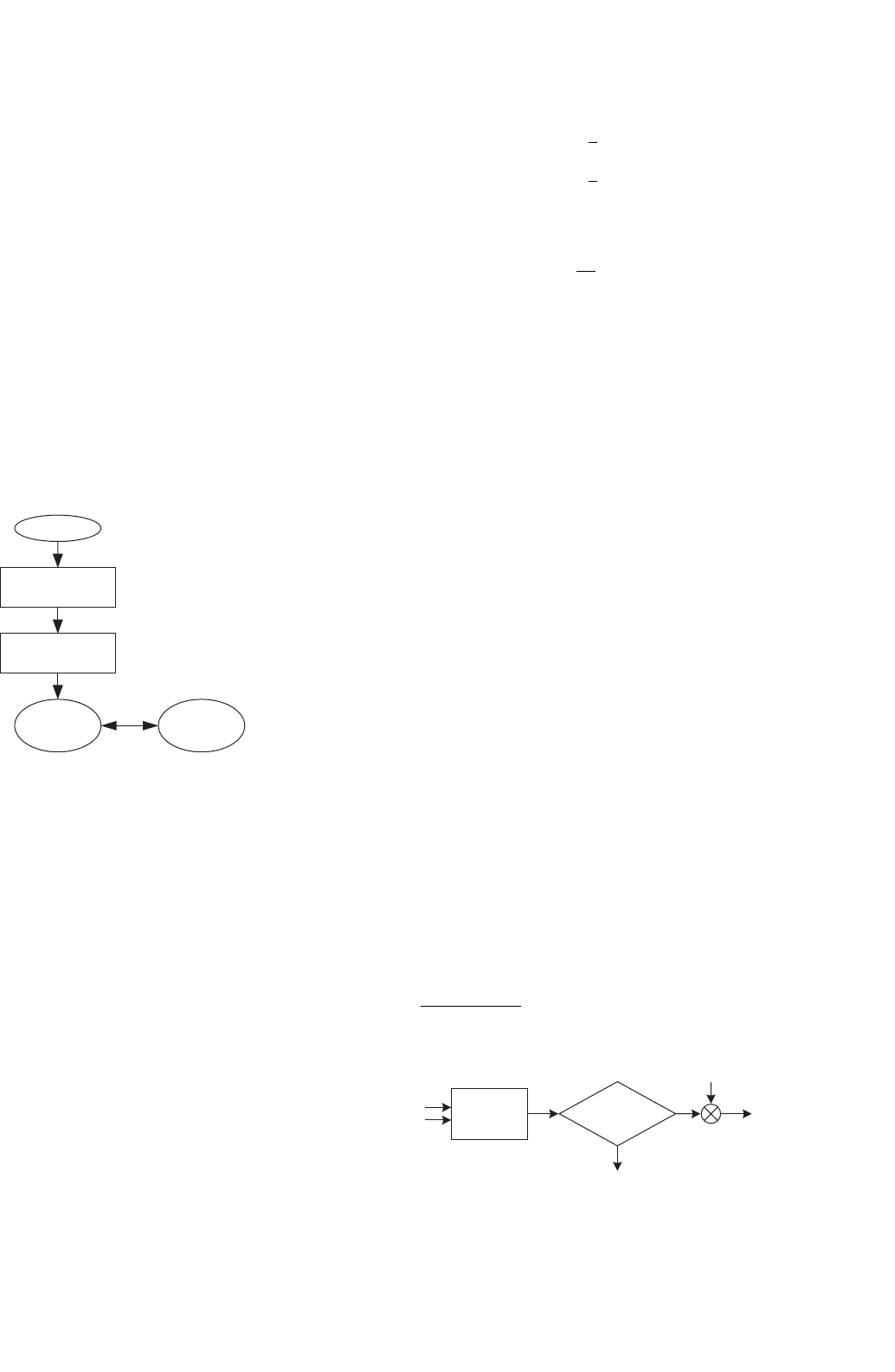
37 DSP-based Control of Variable Speed Drives 1049
points that should be considered during current and speed
measurement, as well as their scaling are discussed.
37.6.3.1 Software Organization
The body of the software consists of two main modules: the
initialization module and the PWM interrupt service routine
(ISR) module. The initialization model is executed only once at
start-up. The PWM ISR module interrupts the waiting infinite
loop when the timer underflows. When the underflow inter-
rupt flag is set, the corresponding ISR is served. Figure 37.25
shows the general structure of the software. The complete FOC
algorithm is executed within the PWM ISR so that it runs at
the same frequency as the switching frequency or at a frac-
tion of it. The wait loop could be easily replaced with a user
interface.
Hardware
Initialization
Start
Variable
Initialization
Inf. Loop
PWM
I.S.R
FIGURE 37.25 General structure of software.
37.6.3.2 Base Values and Per-unit Model
It is often convenient to express machine parameters and
variables of per-unit quantities. Moreover, the LF2407 is a
fixed point DSP, so using a normalized per-unit model of the
induction motor is easier than using real parameters. In this
model, all quantities refer to the base values. Base power and
base voltage are selected, and all parameters and variables are
normalized using these base quantities. Although one might
violate this convention from time to time when dealing with
instantaneous quantities, the rms values of the rated phase
voltage and current are generally selected as the base voltage
for the a–b–c variables while the peak value is generally selected
as the base voltage for d–q variables. The base values are deter-
mined from the nominal values by using Eq. (37.27), where
I
n
, V
n
, f
n
are the nominal phase current, the nominal phase to
neutral voltage, and the nominal frequency in a star-connected
induction motor, respectively. The base value definitions are
as follows:
I
b
=
√
2I
n
V
b
=
√
2V
n
ω
b
= 2πf
n
ψ
b
=
V
b
ω
b
(37.27)
I
b
and V
b
are the maximum values of the nominal phase cur-
rent and voltage, ω
b
is the electrical nominal rotor flux speed,
and ψ
b
is the base flux.
37.6.3.3 Speed Estimation during High-speed Region
As previously mentioned, this method is based on counting
the number of encoder pulses in a specified time interval. The
QEP assigned timer counts the number of pulses and records it
in the timer counter register (TxCNT). As the mechanical time
constant is much slower than the electrical one, the speed reg-
ulation loop frequency might be lower than the current loop
frequency. The speed regulation loop frequency is obtained in
this algorithm by means of a software counter. This counter
accepts the PWM interrupt as input clock and its period is
the software variable called SPEEDSTEP. The counter variable
is named speedstep. When speedstep is equal to SPEEDSTEP,
the number of pulses counted is stored in another variable
called n
p
and thus the speed can be calculated. The scheme
depicted in Fig. 37.26 shows the structure of the speed feedback
generator.
Assuming that n
p
is the number of encoder pulses in one
SPEEDSTEP period when the rotor turns at the nominal speed,
a software constant K
speed
should be chosen as follows:
01000h = K
speed
.n
p
The speed feedback can then be transformed into a Q4.12
format, which can be used in the control software. In the
proposed control system, the nominal speed is 1800 rpm and
SPEEDSTEP is set to 125. The n
p
can be calculated as follows:
n
p
=
1800 ×64 ×4
60
×SPEEDSTEP ×T
p
= 288 (37.28)
Counter
QEP
speedstep is equal
to SPEEDSTEP?
K
speed
w
m
No
yes
No chan
g
e
From
Encoder
FIGURE 37.26 Block diagram of speed feedback calculator.
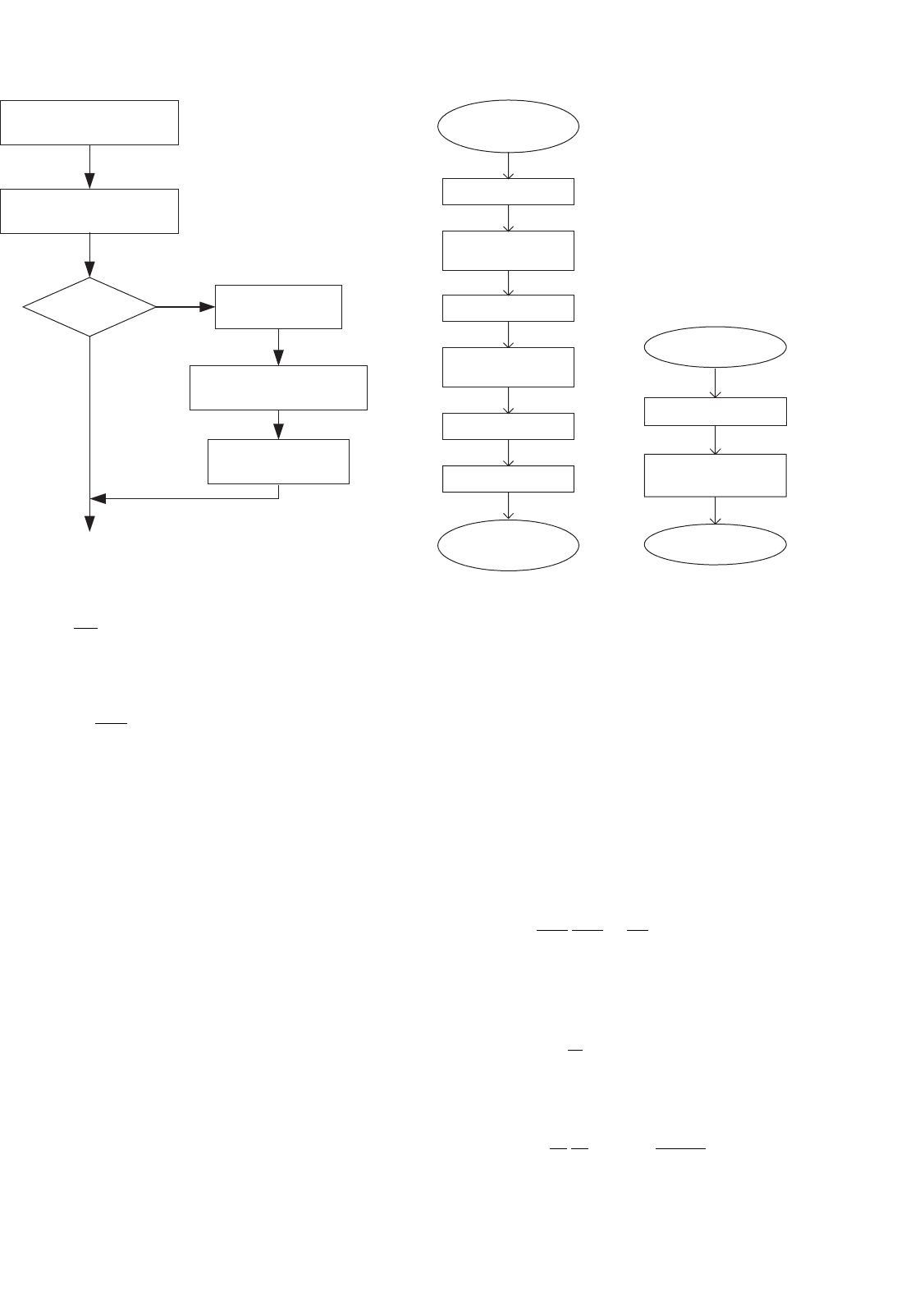
1050 H. A. Toliyat et al.
w = K
speed
*n
p
speedstep = speedstep-1
speedstep = 0
speedstep = SPEEDSTEP
n
p
= TxCNT
Yes
No
TxCNT=0
FIGURE 37.27 Complete flowchart of speed measurement block during
high-speed region.
where T
p
=
3
f
pwm
= 3 × 10
−4
(PWM frequency is 10 kHz
but the program is running at 3333 Hz) and hence K
speed
is
given by:
K
speed
=
4096
288
= 14.22 ⇔ 0E38h Q8.8
Note that K
speed
is out of the Q4.12 format range. The most
appropriate format to handle this constant is the Q8.8 format.
The speed feedback in Q4.12 format is then obtained from the
encoder by multiplying n
p
by K
speed
. The flowchart of speed
measurement is presented in Fig. 37.27.
37.6.3.4 Speed Measurement during Low-speed
Region
To detect the edges of two successive encoder pulses, the devel-
oped program can use either the QEP counter or the capture
unit input pins. The program has to measure the time between
two successive pulses, therefore it must utilize another GP
timer. In this program, Timer 3 has been dedicated to the
time measurement. During the interrupt service routine of
the capture unit or counter QEP, speed can be calculated. To
obtain the actual speed of the motor, the appropriate number
is divided by the value in the count register of Timer 3.
As it can be inferred, at very low speeds an overflow may
occur in Timer 3. The counter would then reset itself to zero
and start counting up again. This event results in a large error
T3CNT=FFFFh
Timer 3
Disable
Start of Timer 3
Overflow ISR
End of Timer 3
Overflow ISR
Temp=T3CNT
T3CNT=0
ACC=31238*32
w=n
p
/8
Enable Timer3
n
p
=ACC / Temp
Start of Capture unit or
Counter QEP ISR
End of Capture unit or
Counter QEP ISR
FIGURE 37.28 Flowchart of speed measurement at low speed.
in speed measurement. To avoid this event, Timer 3 will be dis-
abled in the overflow interrupt service routine. However, this
timer is enabled in the capture unit (counter QEP) interrupt.
The flowchart of this implementation is presented in
Fig. 37.28
37.6.3.5 The Current Model
The Current Model is used to find the rotor flux position.
This module takes i
ds
and i
qs
as inputs plus the rotor electrical
speed and then calculates the rotor flux position. The current
model is based on Eqs. (37.23) and (37.24). Equation (37.23)
in transient form can be written as:
L
r
r
r
L
m
dλ
dr
dt
+
λ
dr
L
m
= i
ds
(37.29)
Assume λ
dr
/L
m
= i
m
where i
m
is the magnetizing current,
therefore Eq. (37.29) can be written as follows:
T
r
d
dt
i
m
+i
m
= i
ds
(37.30)
Rotor flux speed in a per-unit system can be shown by:
f
s
=
1
ω
b
dθ
dt
= ω
re
+
i
qs
T
r
i
m
ω
b
(37.31)
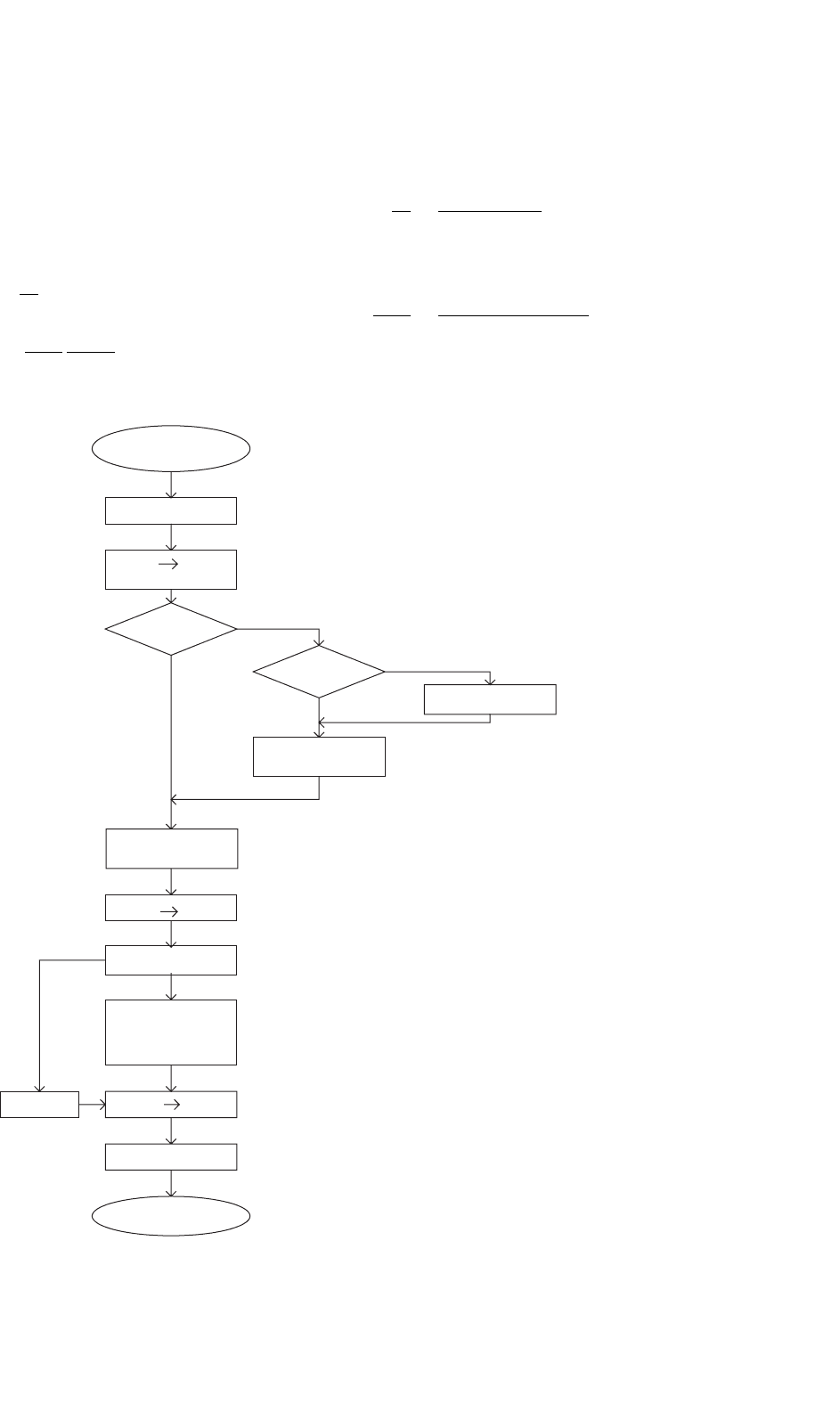
37 DSP-based Control of Variable Speed Drives 1051
where θ is the rotor flux position and T
r
= L
r
/r
r
and ω
re
are
the rotor time constant and rotor electrical speed, respectively.
The rotor time constant is critical to the correct functionality
of the Current Model. This system outputs the rotor flux speed,
which in turn will be integrated to get the rotor flux position.
Assuming that i
qs
(k+1)
≈ i
qs
(k)
, Eqs (37.30) and (37.31) can be
discretized as follows:
i
mr
(k+1)
= i
mr
(k)
+
T
p
T
r
i
ds
(k)
−i
mr
(k)
f
s
(k+1)
= n
(K +1)
+
1
T
r
ω
b
i
qs
(k)
i
mr
(k+1)
(37.32)
Measure Ia and Ib
Regulate
speed?
Calculate speed
Start
Iabc Idqs
Clark Trans.
s
Speed PI regulator,
Calculate Iqs
High speed?
Current Model
Module
Ids and Iqs
to PI regulator
and calculate
V
ds and Vqs
(V
dqs
) (V
dqs
)
New θ
r
.
Space Vector PWM
End
I
dqs
I
dqs
s
e
ee
ee
e
s
Calculate Sin and
Cos of
qr
Yes
No
Yes
No
s
∗
FIGURE 37.29 Flowchart of digital implementation of FOC algorithm.
For example, let the constants T
p
/T
r
and 1/T
r
ω
b
be renamed
to K
t
andK
r
, respectively. Here L
r
= 73.8 mH, r
r
= 0.73 ,
and f
n
= 60 Hz. So for K
t
and K
r
we have:
K
r
=
T
p
T
r
=
(
10000/3
)
−1
101.09 ×10
−3
= 2.967 ×10
−3
⇔ 000Ch Q4.12
K
t
=
1
T
r
ω
b
=
1
30.232 ×10
−3
×377
= 26.237 ×10
−3
⇔ 006Bh Q4.12

1052 H. A. Toliyat et al.
By knowing the rotor flux speed (f
s
), the rotor flux position
(θ
cm
) is computed by the integration formula in the per-unit
system.
θ
cm
(k+1)
= θ
cm
(k)
+ω
b
·f
s
(k)
·T (37.33)
In Eq. (37.33), let ω
b
f
s
T be called θ
inc
. This variable is the
rotor angle variation within one sampling period. Thus, the
Current Model Module has three input variables i
ds
, i
ds
, and
ω
re
and one output, which is the rotor flux position θ
cm
represented as a 16-bit integer value. The flowchart of the
field-oriented speed control of induction motor is presented
in Fig. 37.29. This routine is placed inside the PWM interrupt
service routine.

38
Power Quality
S. Mark Halpin and
Angela Card
Department of Electrical and
Computer Engineering,
Auburn University,
Alabama, USA
38.1 Introduction ........................................................................................ 1053
38.2 Power Quality ...................................................................................... 1054
38.2.1 Steady-state Voltage Frequency and Magnitude • 38.2.2 Voltage Sags
• 38.2.3 Grounding • 38.2.4 Harmonics • 38.2.5 Voltage Fluctuations and Flicker
• 38.2.6 Transients • 38.2.7 Monitoring and Measurement
38.3 Reactive Power and Harmonic Compensation............................................ 1061
38.3.1 Typical Harmonics Produced by Equipment • 38.3.2 Resonance • 38.3.3 Harmonic
Filters
38.4 IEEE Standards..................................................................................... 1063
38.5 Conclusions ......................................................................................... 1065
Further Reading ................................................................................... 1066
38.1 Introduction
Power electronics and power quality are irrevocably linked
together as we strive to advance both broad areas. With the
dramatic increases over the last 20 years in energy conversion
systems utilizing power electronic devices, we have seen the
emergence of “power quality” as a major field of power engi-
neering. The power electronic technology has played a major
role in creating “power quality,” and simple control algorithm
modifications to this same technology can often play an equally
dominant role in enhancing overall quality of electrical energy
available to end-users.
Power electronics has given us, as a industrial society,
a plethora of new ways to manufacture products, provide
services, and utilize energy. From a power quality impact
viewpoint, applications such as
1. Switched-mode power supplies,
2. DC arc furnaces,
3. Electronic fluorescent lamp ballasts,
4. Adjustable speed drives, and
5. Flexible ac transmission components.
are often cause for concern. From the viewpoint of a utility
supply system, these converter-based systems can lead to oper-
ational and life expectancy problems for other equipment,
possibly not owned or operated by the same party. It was
from this initial perspective that the field of power quality
emerged.
In most cases, the same devices and systems that create
power quality problems can also be used to solve power quality
problems. “Problem solving” applications such as
1. Active harmonic filters,
2. Static and adaptive var compensators, and
3. Uninterruptable power supplies.
all utilize the same switching device technology as the “prob-
lem causing” applications.
As the number of potentially problematic power electronic-
based loads has increased over time, so attention has given to
enhanced converter control to maximize power quality. Perfect
examples of these improvements include
1. Unity power factor converters,
2. Dip-proof inverters, and
3. Limited-distortion electronic lamp ballasts.
While these direct product enhancements are not mandatory
in North America, today’s global economy necessitates con-
sideration of power quality standards and limits in order to
conduct business in the European Union.
While many studies suggest increases in power electronic-
based energy utilization as high as 70–80% (of all energy
consumed), it is equally clear that we are beginning to real-
ize the total benefit of such end-use technologies. Power
quality problems associated with grounding, sags, harmonics,
and transients will continue to increase because of the sheer
number of sensitive electronic loads expected to be placed
1053
Copyright © 2001 by Academic Press

1054 S. M. Halpin and A. Card
in service. At the same time, we are only now beginning to
realize the total benefits that such loads can offer.
38.2 Power Quality
The term “power quality” means different things to differ-
ent people. To utility suppliers, power quality initially referred
to the quality of the service delivered as “measured” by
the consumer’s ability to use the energy delivered in the
desired manner. This conceptual definition included such
conventional utility planning topics as voltage and frequency
regulation and reliability. The end-user’s definition of power
quality also centers around their ability to use the delivered
energy in the desired manner, but the topics considered can
be much more specific and include magnitude and duration of
different events as well as waveshape concerns. Fortunately, a
good working definition of power quality has not been a point
of contention, and most parties involved consider “power
quality” to be that, which allows the user to meet their end-use
goals. The working definition is not complicated by particular
issues; engineers are well aware that topics from many aspects
of power engineering may be important.
Power quality can be roughly broken into categories as
follows:
1. Steady-state voltage magnitude and frequency,
2. Voltage sags,
3. Grounding,
4. Harmonics,
5. Voltage fluctuations and flicker,
6. Transients, and
7. Monitoring and measurement.
The remainder of this section discusses each of the major
categories in turn.
38.2.1 Steady-state Voltage Frequency
and Magnitude
In most areas of North America, steady-state frequency regu-
lation is not a significant issue due to the sufficient levels of
generating capacity and the strong interconnections among
generating companies and control areas. In other parts of
the world, and North America under extreme conditions,
frequency can deviate from 1/4 to 1/2 Hz during periods of
insufficient generating capacity. Under transient conditions,
frequency can deviate up to 1–2 Hz.
Frequency deviations can affect power electronic equipment
that use controlled switching devices unless the control sig-
nals are derived from a signal that is phase-locked with the
applied voltage. In most cases, phase locks are used, or the
converters consist of uncontrolled rectifiers. In either case, fre-
quency deviations are not a major cause of problems. In most
TABLE 38.1 ANSI C84.1 Voltage ranges
Service voltage (%) Utilization voltage (%)
Range A 114–125 108–125
Range B 110–127 104–127
Range A is for normal conditions and Range B is for emergency or short-time
conditions.
cases, frequency deviations have more impacts on conven-
tional equipment that does not use electronics or in very
inexpensive electronic devices. Clocks can run fast (or slow),
motor speeds can drop (or rise) by a few revolutions per
minute, etc. In most cases, these effects have minimal eco-
nomic impact and are not considered a real power quality
problem.
Steady-state voltage regulation is a much more pronounced
issue that can impact a wide range of end-use equipment.
In most cases, utility supply companies do a very effective
job of providing carefully regulated voltage within permissi-
ble ranges. In North America, ANSI Standard C84.1 suggests
steady-state voltage ranges both at the utility service entrance
and at the point of connection of end-use equipment. Fur-
thermore, equipment manufacturers typically offer equipment
that is tolerant of steady-state voltage deviations in the range
of ±10%. Table 38.1 shows the voltage ranges suggested by
ANSI C84.1, with specific mention of normal (Range A)
and contingency (Range B) allowable voltages, expressed in
percent.
Virtually all equipment, especially sensitive electronic equip-
ment, can be effected by deviating voltage outside the ±10%
range. In most cases, overvoltages above +10% lead to loss of
life, usually over time; excessive overvoltages can immediately
fail equipment. Undervoltages below −10% usually lead to
excessive current demands, especially for equipment that has a
controlled output like an adjustable speed drive controlling a
motor to a constant speed/torque point. The impacts of these
prolonged excessive currents can be greater voltage drop, tem-
perature rise in conductors, etc. In the extreme, undervoltages
of greater than 15–20% can cause equipment to immediately
trip. In most cases, such extreme undervoltages are associated
with system faults and the associated protection system. These
extreme undervoltages are so important that they are classified
in a power quality category of their own called voltage sags.
38.2.2 Voltage Sags
Other than improper grounding, voltage sags are probably the
most problematic of all power quality problems. At this time,
a number of standards-making bodies, including IEEE, ANSI,
and IEC, are working on standards related to sags. In most
cases, sags are generally agreed to be more severe and outside
of the scope of ANSI C84.1 and they are temporary in nature
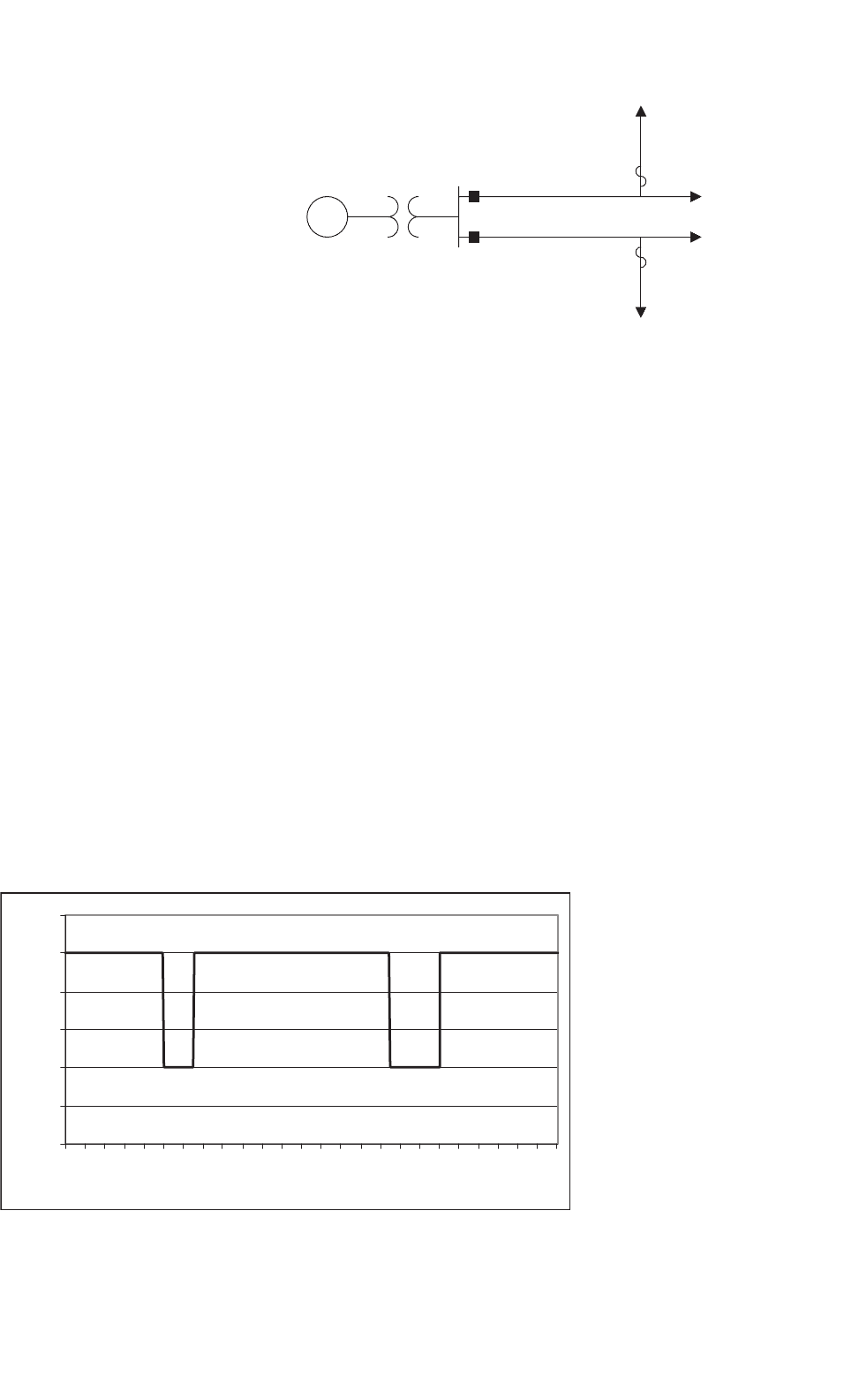
38 Power Quality 1055
due to the operation of system protection elements. Because
the electrical system is a continuous electrical circuit, faults
in any location will have some impact on voltages through-
out the network. Of course, areas closer to the faulted area
will see a greater voltage sag due to the fault than other, more
(electrically) remote areas. Sags can originate anywhere in a
system, but are more pronounced in utility distribution sys-
tems because of the greater exposure of low-voltage systems to
the causes of short circuits.
Most utility companies implement distribution system pro-
tection in what is known as a “fuse saving” methodology.
Figure 38.1 shows a typical overhead distribution system with
two feeders being supplied from the same substation trans-
former. Each primary circuit has its own automatic circuit
recloser (ACR) and shows one fused tap.
With the protection system set up based on fuse-saving
methodology, any fault downstream of a fault will be cleared
first by the substation recloser followed by a reclosing oper-
ation (re-energization of the circuit) 1/2–2 later. If the fault
is still present, the closest fuse should blow to permanently
isolate the fault. (Note that in some cases, multiple reclosing
attempts are made prior to the clearing of the fuse.)
For a fault on the load side of fused tap #2 in Fig. 38.1, cus-
tomers on feeder #1 will see a voltage sag determined by the
system and transformer impedance at the substation. Because
this impedance is typically on the same order (or larger) as
the feeder circuit impedance, a sag in substation bus voltage of
50% is common. This sag will persist until feeder #2 is cleared
by the recloser opening. When the recloser re-energizes the
circuit, a permanent fault will still be present and the substa-
tion bus will again experience a voltage sag. Of course, any sag
in substation bus voltage will be delivered directly to all cus-
tomers on feeder #1, even though there is no electrical problem
on that feeder. Figure 38.2 shows a possible rms voltage pro-
file that might be supplied to the customers on feeder #1 for
0
20
40
60
80
100
120
0
0.1
0.2
0.3
0.4
0.5
0.6
0.7
0.8
0.9
1
1.1
1.2
1.3
1.4
1.5
1.6
1.7
1.8
1.9
2
2.1
2.2
2.3
2.4
2.5
Time (s)
Voltage (%)
FIGURE 38.2 The rms voltage supplied to feeder #1 customers.
Utility
equivalent
Substation
transformer
Feeder #1
Feeder #2
Fused Tap #2
Fused Tap #1
FIGURE 38.1 Overhead distribution system.
a permanent fault on the load side of fused tap #2. Only one
recloser operation is shown prior to fuse clearing.
Just based on the voltage information shown in Fig. 38.2, it
is impossible to tell if the end-use loads on feeder #1 will expe-
rience a problem. Equipment tolerance curves are required to
assess the vulnerability of equipment to voltage deviations,
including sags, and all equipment is different. Figure 38.3
shows the lower portions of two equipment tolerance curves,
the (older) CBEMA and the (newer) ITIC curves for com-
puter equipment. Most, but not all, power electronic-based
equipment has a similar shape. Voltage sags with a duration
that correspond to a point that is “below and to the right” of
the tolerance curve will result in loss of equipment function,
while sags of duration that plot “above and to the left” of the
tolerance curve will not effect equipment performance. Note
that only the lower portion of the curve has been shown; an
upper tolerance curve also exists that is often used in transient
(overvoltage) studies.
Voltage sags are probably the most common power quality
problem that is “given” to the end-user by the supplying utility.
However, improper equipment grounding is responsible for
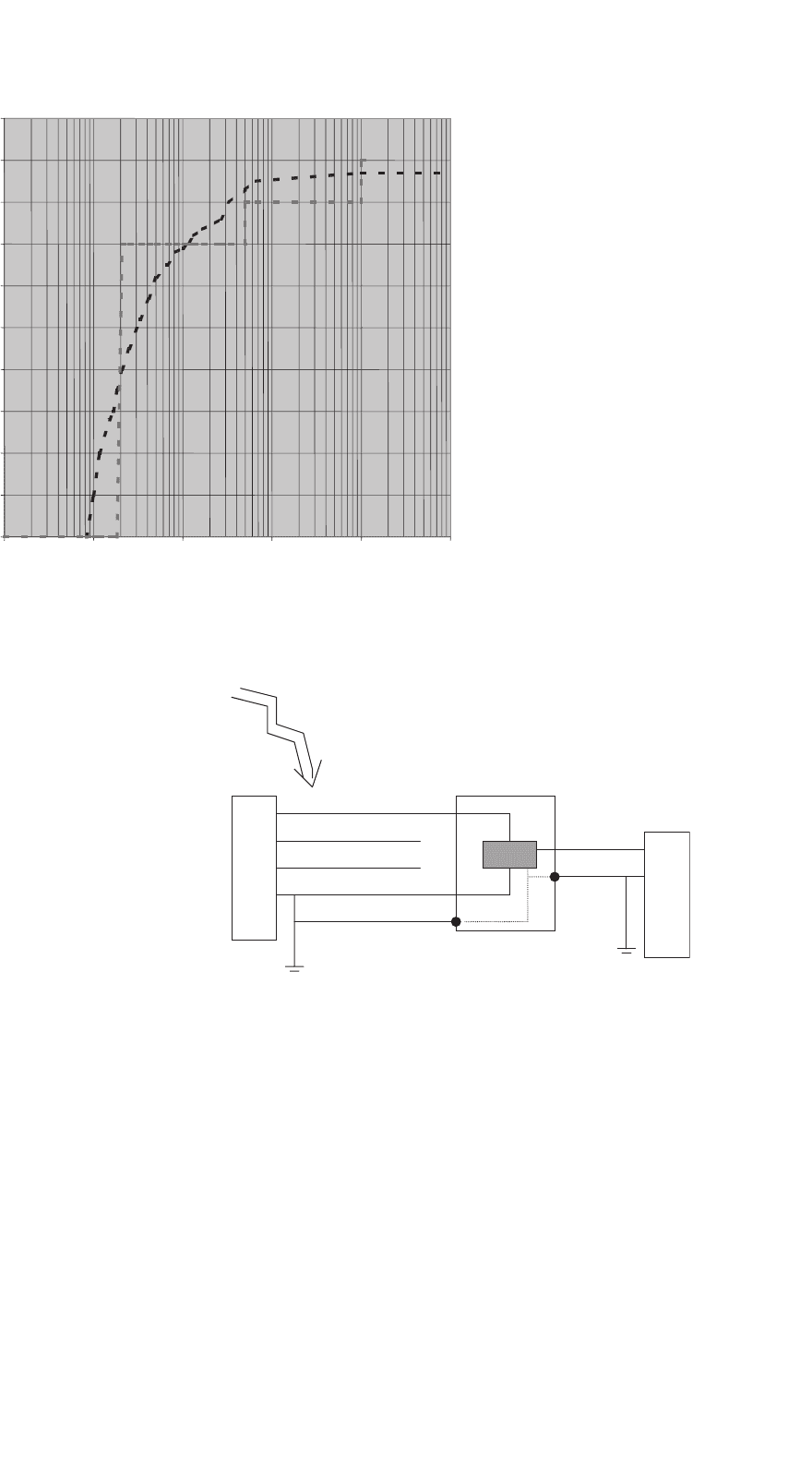
1056 S. M. Halpin and A. Card
0
10
20
30
40
50
60
70
80
90
100
1.00 10.00 100.00 1000.00 10000.00 100000.00
Duration of Sag (milliseconds)
[0 to 6,000 Cycles]
% of Nominal Voltage
FIGURE 38.3 CBEMA (curved line) and ITIC (square shape) tolerance curves.
the vast majority of power quality problems on the customer’s
side of the meter.
38.2.3 Grounding
Grounding of equipment was originally conceived as a per-
sonnel safety issue. However, the presence of an electrical
conductor that is at zero potential has been widely used in
many power electronic and microprocessor-controlled loads.
In the United States, electrical systems in residential, com-
mercial, and industrial facilities fall under the purview of the
National Electric Code (NEC) which establishes specific cri-
teria for grounding of equipment. While it was once thought
that proper grounding according to the NEC was detrimental
to power quality concerns, these opinions have gradually faded
over time.
From a power quality perspective, improper grounding can
be considered in three broad categories
1. Ground loops,
2. Improper neutral-to-ground connections, and
3. Excessive neutral-to-ground voltage.
The ground loop problem is a significant issue when power,
communications, and control signals all originate in different
locations, but come together at a common electrical point.
Transients induced in one location can travel through the
created ground loop, damaging equipment along the way.
A
B
C
N
G
P
O
W
E
R
C
O
N
T
R
O
L
Load Equipment
FIGURE 38.4 Powering and control ground loop.
Improper neutral-to-ground connections will create a “noisy”
ground reference that may interfere with low-voltage com-
munications and control devices. Excessive neutral-to-ground
voltage may damage equipment that is not properly insulated
or that has an inexpensive power supply.
Figure 38.4 shows a common wye-connected service
(assumed at the terminals of a transformer) that supplies
power to equipment that is also remotely monitored and
controlled from another location with a separate ground
reference.
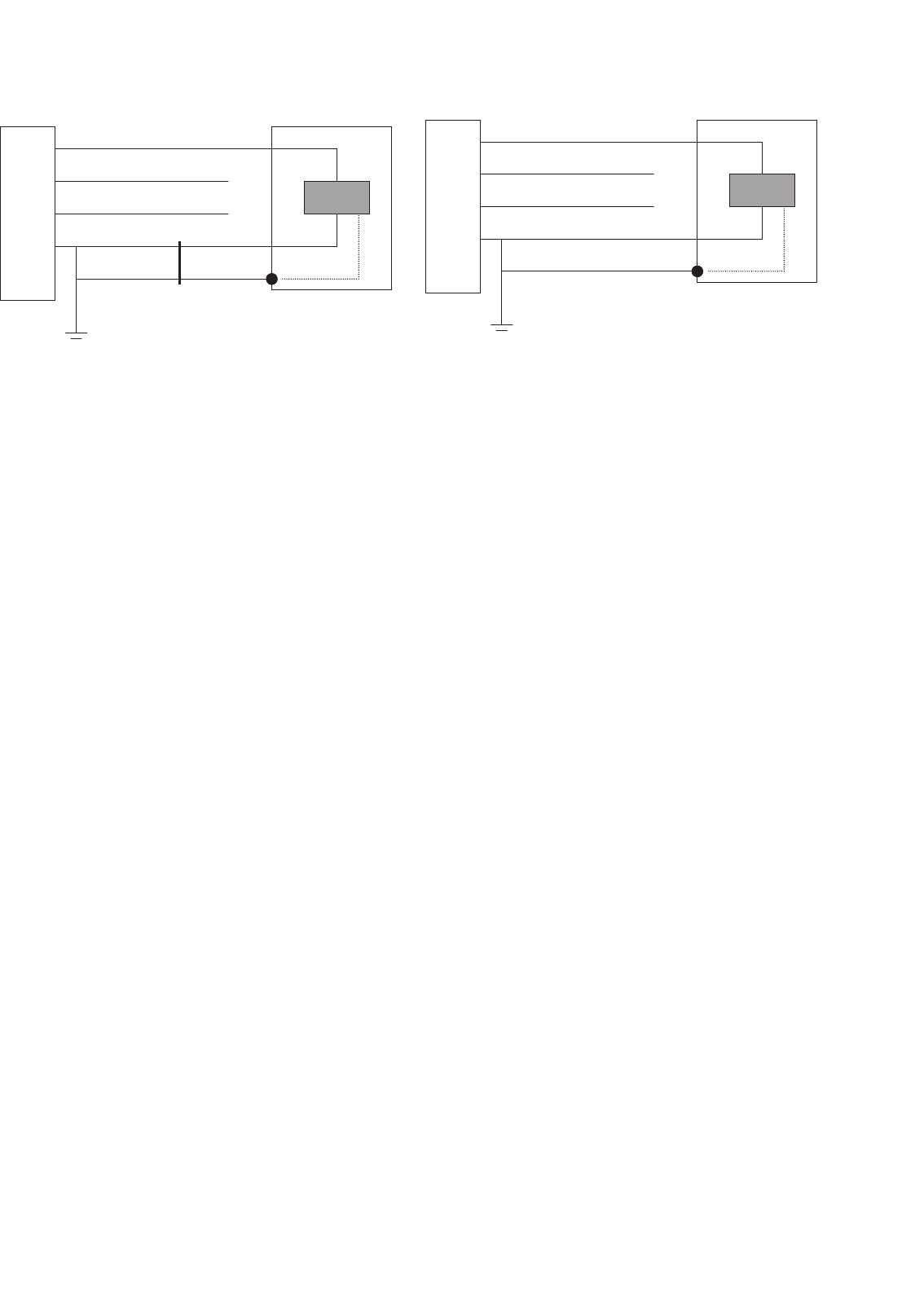
38 Power Quality 1057
A
B
C
N
G
P
O
W
E
R
Load Equipment
FIGURE 38.5 Improper neutral-to-ground connections.
For any shift in ground potential for the power circuit, often
caused by lightning as shown in Fig. 38.4, potentially large cur-
rents can flow through the grounding circuits and through the
sensitive electronic equipment. Such currents can easily lead
to equipment damage. Situations like these are common in
1. Residential areas, if power and CATV or telephone
grounds are not the same and
2. Commercial and industrial complexes consisting of
multiple buildings with linking communications, com-
puter, or control circuits, when each building has its
own power service (and therefore ground).
Figure 38.5 shows an example of an improper neutral-to-
ground connection, and how this connection can create power
quality problems.
Load current returning in the neutral conductor will, at
the point of improper connection to ground, divide between
neutral and ground. This current flow in the ground conductor
will produce a voltage at the load equipment, which can easily
disrupt equipment operation.
Figure 38.6 shows an example of the possibility for exces-
sive neutral-to-ground voltage and how this can lead to power
quality problems.
For load equipment that produces significant voltage drop
in the neutral, such as laser printers and copying machines
when the thermal heating elements are on, the voltage from
the neutral-to-ground reference inside the equipment can
exceed several volts. In many cases, this voltage is sufficient
to damage printed circuit boards, disrupt control logic, and
fail components.
38.2.4 Harmonics
In most cases, power electronic equipment is considered to
be the “cause” of harmonics. While switching converters of
all types produce harmonics because of the non-linear rela-
tionship between the voltage and current across the switching
A
B
C
N
G
P
O
W
E
R
Load Equipment
FIGURE 38.6 Excessive neutral-to-ground voltage.
device, harmonics are also produced by a large variety of
“conventional” equipment including
1. Power generation equipment (slot harmonics),
2. Induction motors (saturated magnetics),
3. Transformers (overexcitation leading to saturation),
4. Magnetic-ballast fluorescent lamps (arcing), and
5. AC electric arc furnaces (arcing).
All these devices will cause harmonic currents to flow and
some devices, actually, directly produce voltage harmonics.
Any ac current flow through any circuit at any frequency
will produce a voltage drop at that same frequency. Harmonic
currents, which are produced by power electronic loads, will
produce voltage drops in the power supply impedance at those
same harmonic frequencies. Because of this inter-relationship
between current flow and voltage drop, harmonic currents
created at any location will distort the voltage in the entire
supply circuit.
In most cases, equipment is not overly sensitive to the
direct impacts of harmonic current flow. Note, however, that
equipment heating is a function of the rms value of the cur-
rent, which can significantly exceed the fundamental frequency
value when large harmonic components are present. It is
because harmonic currents produce harmonic voltages that
there is a real power quality concern.
Most equipment can operate satisfactorily as long as the
voltage distortion at the equipment terminals does not exceed
around 5%. Exceptions to this general rule include ripple-
control systems for converters (which are impacted by small
even-order harmonics) and small harmonics at sufficiently
high frequency to produce multiple zero crossing in a wave-
form. (Note that voltage notching due to simultaneous com-
mutation of switching devices can also create multiple zero
crossings.) Such a multiple crossing scenario is shown in
Fig. 38.7 and represents a 60 Hz waveform plus a 1% voltage
harmonic at 3000 Hz.
Converters that have a time-limited firing signal can directly
suffer from excessive voltage distortion. For a six-pulse
